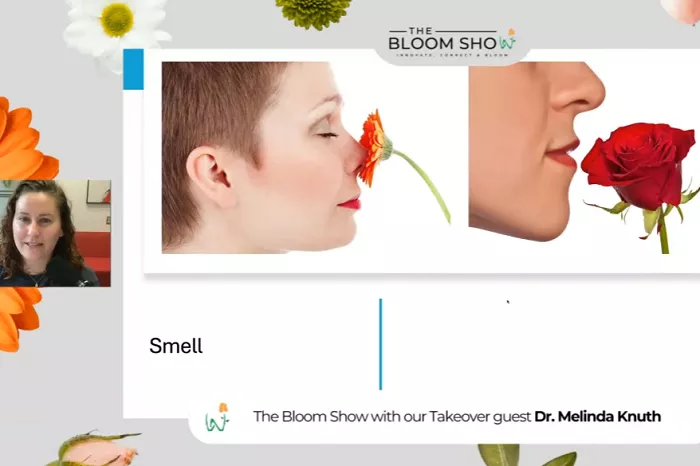As the floriculture industry peers into the future of 2025, it is evident that consumer expectations are undergoing significant changes. The next wave of growth in this sector might emerge from an area that has not been fully tapped into yet: scent.
During a recent episode of The Bloom Show, Dr. Melinda Knuth, Assistant Professor at NC State University and host of the Growing the Future podcast, presented a novel perspective on floriculture marketing. Instead of sharing a completed case study, she introduced a research-backed hypothesis: Could scent be a meaningful, yet unexplored, dimension of the floral experience?
Leveraging horticultural research and her decade-long experience in floral consumer studies, Dr. Knuth raised questions that the industry has not seriously considered in years. Can scent influence consumer preferences in floriculture? Would consumers be willing to pay more for a scented bloom? Could strategic fragrance help florists establish deeper emotional connections with buyers?
For florists, breeders, and marketers, this discussion was not merely academic; it was a call to reconsider how they engage the senses, especially in an era where emotional connection and floral trends are closely intertwined.
From Curiosity to Research
“The smell may be more important than we understand,” Dr. Knuth remarked during the episode. This insight prompted her to delve into how fragrance could play a more significant role in shaping consumer perceptions and choices regarding flowers.
Her interest in scent was sparked by conversations with designers, growers, and retail professionals who highlighted fragrance as an often-overlooked aspect of the floral experience. Some noted how a bloom’s scent could add an unexpected layer of depth to a design, while others questioned why many cut flowers no longer possess a noticeable aroma.
What We Know About Scent and the Brain
Scent is not just a matter of preference; it is deeply rooted in how the human brain processes memory and emotion. Dr. Knuth explained that scents are detected through volatile organic compounds (VOCs), many of which are naturally produced by flowers. These VOCs interact with the brain’s limbic system, the same region responsible for emotion, behavior, and memory.
This is why a whiff of lavender can induce calmness, or why roses might evoke childhood memories. Although this phenomenon has been extensively studied in food and fragrance marketing, it remains largely unexplored in the context of cut flowers. This gap presents a significant opportunity for the floriculture industry.
Asking the Right Questions
“Will people pay more money for a scented versus an unscented flower if they look exactly the same?” Dr. Knuth asked. “Or are they going to pay more attention to those flowers, meaning they are more likely to spend more time looking at them?”
Dr. Knuth and her colleagues began to explore several key questions:
- Will consumers pay more for scented flowers, all else being equal?
- Does scent increase the time consumers spend evaluating flowers?
- Could fragrance lead to stronger brand recall or in-store engagement?
While definitive answers are still pending, the very act of posing these questions has already begun to shift the conversation within the floriculture industry.
Marketing Implications for Florists and Breeders
For florists, this research opens up new avenues for experimentation. Could scent diffusers near point-of-sale areas subtly enhance the floral experience? Could scented packaging or product lines offer seasonal or memory-based themes that align with consumer emotions?
For breeders, it raises new considerations about priorities. If consumers respond positively to scent—and are willing to pay more for it—could fragrance become a factor in breeding decisions again? And how can this feedback be effectively communicated up the supply chain?
These questions are particularly relevant given the 2025 floriculture marketing trends, where emotional connection, sensory branding, and immersive customer experiences are emerging as key differentiators.
What’s Next for the Industry
“One of the things that myself as well as my colleagues are looking at is what words trigger that appeal towards smell. So how should we talk about smell in the marketing of cut flowers, ornamental products, and herbs?” Dr. Knuth elaborated.
Which words inspire connection? How do shoppers react to scent-themed product descriptions? These may seem like minor details, but they are strategic steps toward developing a vocabulary around fragrance that resonates with modern consumers.
And perhaps most importantly, they serve as a reminder that floriculture marketing is not static. Like scent itself, it is dynamic, nuanced, and capable of evoking feelings that go beyond logic.
Conclusion: A Fragrant Frontier
In a data-driven world, scent reminds us that not every decision is rational. Sometimes, it is sensory. Sometimes, it is emotional. And sometimes, it is entirely subconscious.
As consumer preferences in floriculture shift toward connection and experience, fragrance may emerge as the next great differentiator. It is not a guarantee, but a question worth pursuing.
For florists and breeders ready to think beyond color palettes and stem lengths, the future of floral innovation might be right under our noses.


